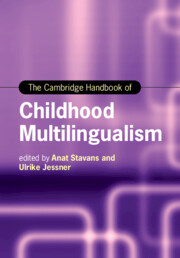Book contents
- The Cambridge Handbook of Childhood Multilingualism
- Cambridge Handbooks in Language and Linguistics
- The Cambridge Handbook of Childhood Multilingualism
- Copyright page
- Contents
- Figures
- Tables
- About the Editors
- Contributors
- Acknowledgments
- Multilingualism Is Not Bilingualism +1: An Introduction
- Part One Becoming and Being a Multilingual Child
- Part Two Cognition and Faculties in Multilinguals
- Part Three Family Language Policy
- 11 Establishing and Maintaining a Multilingual Family Language Policy
- 12 Parental Input in the Development of Children’s Multilingualism
- 13 Multilingualism, Emotion, and Affect
- 14 Siblings’ Multilingual Discourse
- Part Four Language(s) and Literacy of Multilingual Children through Schooling
- Part Five Socialization in Childhood Multilingualism
- Part Six Multilingual Children’s Landscape
- Subject Index
- Country Index
- Language Index
- References
14 - Siblings’ Multilingual Discourse
from Part Three - Family Language Policy
Published online by Cambridge University Press: 18 August 2022
- The Cambridge Handbook of Childhood Multilingualism
- Cambridge Handbooks in Language and Linguistics
- The Cambridge Handbook of Childhood Multilingualism
- Copyright page
- Contents
- Figures
- Tables
- About the Editors
- Contributors
- Acknowledgments
- Multilingualism Is Not Bilingualism +1: An Introduction
- Part One Becoming and Being a Multilingual Child
- Part Two Cognition and Faculties in Multilinguals
- Part Three Family Language Policy
- 11 Establishing and Maintaining a Multilingual Family Language Policy
- 12 Parental Input in the Development of Children’s Multilingualism
- 13 Multilingualism, Emotion, and Affect
- 14 Siblings’ Multilingual Discourse
- Part Four Language(s) and Literacy of Multilingual Children through Schooling
- Part Five Socialization in Childhood Multilingualism
- Part Six Multilingual Children’s Landscape
- Subject Index
- Country Index
- Language Index
- References
Summary
This chapter explores the integral role that siblings’ multilingual discourse plays across diverse family lives and sites of learning. In discussing key concepts in the field of family studies, young children are viewed as spending as much if not more time with siblings than their parents. This chapter looks at siblings as agentive in shaping the language environment in multilingual families and reflects on research in the area of siblings’ language choices, humour and intimacy as well as sibling rivalry in multilingual discourse. A distinctive feature of sibling relationships is their seriality, and research on the ‘niche’ of each child is looked at in relation to a child’s emerging multilingualism. Siblings’ multilingual discourse is viewed as dynamic and their language practices as in flux as the family grows, moves, or separates. Research on siblings as literacy mediators and studies on their creative multilingualism are examined. This chapter recognises the key role of digital technology in children’s lives and examines siblings’ multilingual discourse in these new digital spaces. New research is shared that investigates how multilingual siblings worked together on an international digital storytelling project.
- Type
- Chapter
- Information
- The Cambridge Handbook of Childhood Multilingualism , pp. 325 - 352Publisher: Cambridge University PressPrint publication year: 2022

